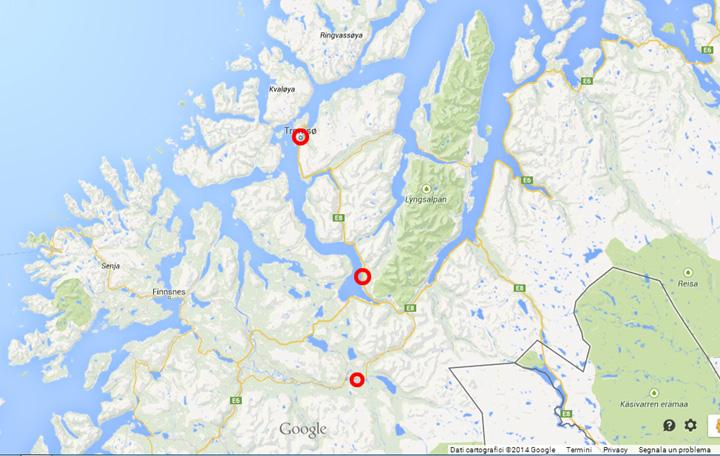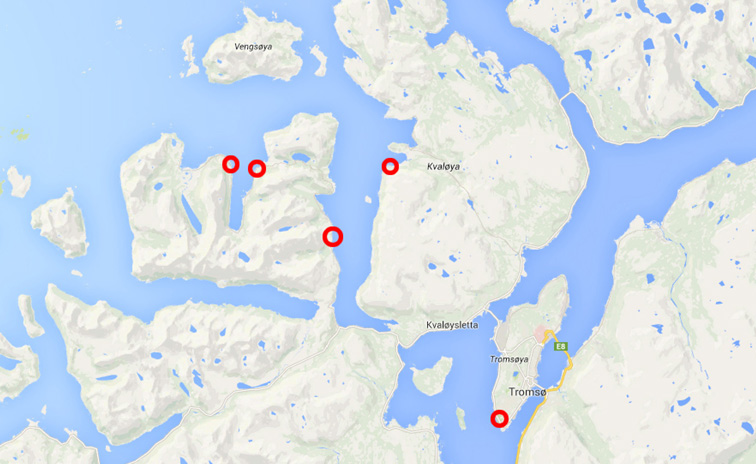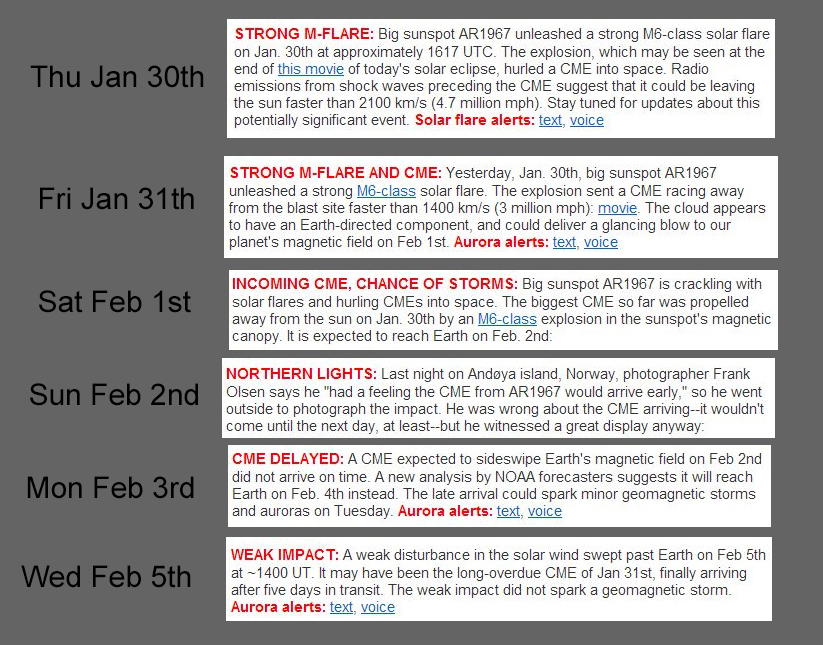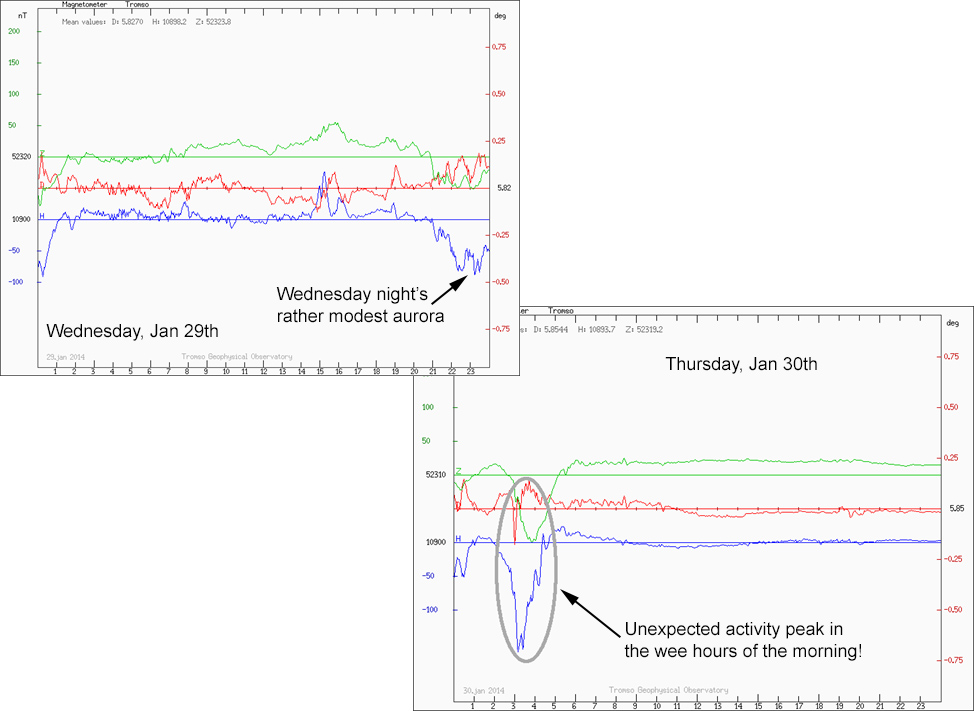Shooting auroras was one of the (few :-D ) things still missing from my hardcore amateur astronomer checklist. Back in 2012 and 2013 some friends of mine, among whom Lorenzo Comolli, had gone on aurora-chasing trips with very encouraging results. The auroral activity is not always present, or, better, it is rather frequent but highly unpredictable, with a higher probability of events in the years around solar activity maximum and in the months around the equinoxes (February, March, September and October). It was something I'd been thinking about for a long time, but I'd never managed to find a good opportunity and the right people with whom to share this experience. Moreover, the solar activity was slowly fading and for this reason I had to hurry up.
In late 2013, I finally got around to organizing an expedition with some good friends of mine (Paola Battaglia, Filippo Riccio e Stefano Magni of the Circolo Astrofili di Milano) from Saturday, January 25, 2014 till Saturday, February 1st, 2014.
Our choice got almost immediately in favor of Tromso, in Northern Norway, for some very good reasons. It is a rather big, modern and organized city lying at the right latitude (around 70° N) on the shores of the Northern Atlantic Ocean, with a climate largely mitigated by the Gulf Stream. The downside to this is that the whole area is exposed to cloud fronts and low pressure areas coming from the Atlantic: hence the high cloud cover figures typical of this area. My proposal to go to Lapland got turned down right away, because in exchange for clearer skies, it has a much harsher climate (average temperatures from -20 to -15 °C vs. -6 °C of the Tromso area).
Note: click here if you want to jump directly to the results and pictures section
Since it was my first time ever imaging the northern lights, I had to spend some time preparing my gear and preparing a shooting schedule. One important I had to take into account was that I would be operating my cameras in a very cold environment, therefore my batteries would drain out quickly. Heres my final setup:
Since my main goal was to shoot as many frames as possible to compose a time-lapse movie, in the beginning I had planned to take a motorized panoramic head with me, which unfortunately I had to leave home because of checked in baggage limits. With hindsight, I regretted not having it with me in the field more than once.
Our departure was scheduled for Saturday January 25th. A double stopover flight (Milan Malpensa Copenhagen Oslo Tromso) took the whole day and landed us at Tromso at 9:00 pm local time: upon our arrival, the sky was mostly cloudy / overcast with no stars visible. After getting our rental car, we went to the hotel and then out for dinner. While in a pub, I checked out the (almost) real-time geomagnetic readings of Tromso magnetometer, to I find out that rather strong auroral activity was ongoing. We rushed to our car, and with our setup we moved to a slightly darker location on the island were the main part of the town of Tromso is located. It was about 1 am when we managed to catch a short glimpse of our very first aurora through the clouds. Unfortunately, we didn't even have enough time to set up, that the aurora was completely gone.
On January 26th we got up under a mostly cloudy sky, and rather unfavorable weather prospects for the coming night and days. Since we were not familiar at all with the area, we resolved to join a guided tour. Despite their high price tag (about 110 EUR per person for a 6h-guided tour), we reckoned that, being very familiar with the territory, they would be able to take us to places with better weather prospects. The rendez-vous is at 6 pm in front of one of Tromso's best hotels: upon departure, the guides announced they'd be driving inland, where the weather was expected to be much colder, but also clearer.
After more than an hour's drive, we stopped at a parking lot along a mountain road, in a very dark spot close to the banks of a frozen lake. The weather was much colder (around -12 °C with a strong wind), but in turn there was little cloud. We set up our gear and waited for something to happen: unfortunately after one hour and a half nothing had shown up yet, so our guides decided to head back to Tromso. On our way back, we stopped at a parking area along the E8 highway at about 60 km from Tromso. The weather was still clear, it was much warmer as we had gotten much closer to the sea, but the new observing site was rather poor since it was located along a rather busy road, with headlights of trucks and cars disturbing the view. But this time Lady Luck was indeed with us, because finally after a while the northern lights showed up. It started out as some dim streaks over the northern horizon, but soon it grew into a host of wavy ribbons overhead. Observing my first aurora was really a breathtaking experience, because it is a fascinating phenomenon with an ever-changing trait to it, which no picture or no movie whatsoever will ever be able to convey. The biggest surprise was its variability: countless curtains, streaks and ribbons keep changing all the time, or they die out only to suddenly build up again somewhere else in the sky, overhead or behind us. The colors vary according to the pattern intensity, from shades of gray in the dimmest parts (as we know, color perception in the human eye gets triggered only above a certain level of intensity) to shades of green as it grows brighter, and even red. The show went on for about one hour, than faded away: then the time came to head back to Tromso, still with the vivid memories of our very first aurora in our minds. One's first aurora is never forgotten! :-D
The next day, January 27th, the weather was fair with some scattered clouds, and the forecast for the coming days was even better. This time we opted for the do-it-yourself aurora hunting trip, as the guided tours were too expensive and, after all, we had to make the most of our rental car, hadn't we? :-D
This time, given the better weather prospects, we decided to go for an observing location close to the seaside. There were a few popular spots on the island of Kvaloya, at about 30 km (or a 50-60 min drive) from downtown Tromso to the northwest. This seemed way better than the previous day, also from a climatic point of view.
Therefore, we grabbed our gear and set forth for Grotfjord in the early evening. Unfortunately (well, not so, actually :-D ), the northern lights caught us along the way: we then decided to stop by the road and quickly set up our cameras. This time too the activity started out rather quietly, with some dim wavy ribbons up in the northern sky. However, as time passed by, the show soon grew more and more spectacular, with curtains and festoons rapidly moving around in the sky, until at some point the whole sky got filled with a bright green wave, literally flooding the snowy landscape and the sea nearby with shades of green. This incredible view had us standing in awe, screaming and yelling like little children: it was about 11 pm. Subsequently, the northern lights slowly started a fading trend, but there still was time for a couple of flares before everything faded away by about 00:30. This aurora show turned out to be by far the best we ever had: sometimes it would change so rapidly in brightness and shape, I didnt know where to point my camera. One lesson I learned from this experience: never change the framing too often, because this will result in a choppy time-lapse movie with too short and fast-changing scenes.
On January 28th we decided to visit the Island of Senja, at about three hours' drive from Tromso, always by good weather. Unfortunately the very short duration of the day prevented us from fully enjoying the wonderful landscapes this island can offer: the sharp snowy peaks and steep cliffs directly plunging into the sea treated us with great views, and I can only imagine what it would be like to be there during a summer sunny day! On our way back we stopped along the E8 to view the aurora, in the very same spot as the previous Sunday with the guided tour. Although the observing location was not certainly the best one, we managed to watch a decent aurora for the third night in a row.
On January 29th the weather got a bit worse, with some broken cloud: at time the Sun low above the southern horizon would pierce its way through the clouds, but it was way cloudier than the previous day. In spite of this we decided to head for Grotfjord, although a bit later than usual (around 11 pm). This time we managed to get to Grotfjord, but the aurora put on a rather modest show with only a couple of minor bursts. By midnight the show was over, so we decided to drive back to Tromso. Much to our disappointment, the following morning we found out that the activity had flared up again between 2 and am! What a pity but this is only one of the many challenges aurora hunters are faced with!
On Thursday, January 30th, we woke up with a wonderful, crystal-clear morning, with a deep blue sky. It stayed like that during the following night. This time we reckoned we wouldnt let any late-night show fool us again. So we set up by the seaside at Grotfjord around 11 pm, ready to even pull an all-nighter to catch a glimpse of the northern lights. The night was really wonderful, with the winter milky way splitting the starry sky into half when we got there. This offered me a good opportunity to note the differences with our mid-latitude sky: the Polar star lies so higher up in the sky, almost at the zenith, while Orion is very low above the horizon (with Rigel culminating at a mere 12-degree altitude) and some summer constellations such as Lyra or Cygnus are completely circumpolar. We stayed up in our car until 4 am, but to no avail: the clearest night of our stay left us without the slightest bit of northern lights. What a disappointment this was!
Friday the 31st of January was our last day (and our last night) in Norway. Although it had been mostly cloudy during the day, we managed to watch our last aurora (a very dim one indeed) through some occasional break in the clouds.
On Saturday, February 1st, the time came to kiss Norway goodbye, with another double-stopover flight that took us back to Italy in the evening. Its been a really wonderful adventure: too bad we didnt stay there on Saturday night, as it turned out they had a great show!
Below you can find the maps with our observing locations (from Google Maps):


For sure, the most suitable (and beautiful) viewing spots were:
All of the the above are are good for observing because they are located far from any light pollution source. As it turned out, it is not easy to find dark spots in this part of Norway, because all inhabited places (even isolated houses) are always well illuminated.
In order to view auroras, two conditions must be met: there has to be some activity and, of course, the weather has to be clear enough to allow the view: a combination which is not so likely at such northerly locations :-D . We all know that making reliable weather forecast is no easy task (although the use of very detailed mathematical models over the last decade or so has greatly increased reliability): predicting auroras is even more complicated.
Northern lights are the result of the complex interaction of many concurrent factors, the most important of which is solar activity. However, it is really difficult to predict if and when an explosive event that took place on the solar surface (Coronal Mass Ejection, or CME) will hit the Earth and how it will be able to affect the geomagnetic activity.
We equipped ourselves with several aurora forecasting apps for smartphones. We always closely monitored the aurora forecasting website of the University of Alaska (offering the so-called Kp index). We even consulted specialized solar flare monitoring websites. In the end all of our efforts turned out to be pretty much useless:
Below you can find a collection of Spaceweather.com headlines with CME impact announcements put off day after day.

Here is the January 29th/30th "aurora bummer":

The magnetometer is the only reliable source for (almost) real-time data. With good weather, it is sufficient to move to a dark location and look up :-D , but if it is cloudy, magnetometer readings are useful to know if there is some activity going on, and therefore if it's worth driving around to search for a break in the clouds.

To sum up, northern lights are largely unpredictable and aurora chasers can do very little about it. Except, of course, planning their trips to suitable locations and in the suitable time periods, in particular around solar activity peaks and in the immediately following two or three years. Then, we can only keep our fingers crossed!
The table below depicts the overall weather and auroral activity conditions we experienced during our journey. My aurora quality rating (1 to 5 stars) is of course very subjective as is it based only on my viewing experience, which is limited only to this trip (my very first aurora-hunting one).
| Date | Weather |
Aurora (1 to 5 "*") |
Remarks |
| Sat Jan 25th | Mostly cloudy to overcast | * * * * (?) | Landed at 9 pm; managed to catch a glimpse through the clouds around 1 am |
| Sun Jan 26th | From mostly cloudy during the day, to fair during the night | * * * * | Took part in a guided tour. Pretty good show |
| Mon Jan 27th | Scattered clouds to fair | * * * * * | Breathtaking show, by far the best of our journey |
| Tue Jan 28th | Scattered clouds | * * * * | Good show |
| Wed Jan 29th | Scattered clouds | * * / * * * * (?) | "Average" show, with a bright flare later in the night |
| Thu Jan 30th | Clear | - - | WONDERFUL day and crystal-clear sky, but NO activity |
| Fri Jan 31st | Cloudy, got a bit better in the evening | * * | Northern light visible but rather dim |
| Sat Feb 1st | Scattered clouds | * * * * (?) | Good activity, but we'd already left... |
The temperature during our observing sessions varied from -12 °C to -3 °C: rather cold, indeed, but not so much if the season and place are taken into account. All in all, I think we were VERY lucky, especially from a weather standpoint: I don't think a whole week with mostly clear weather is exactly normal for Tromso. Even five nights out of seven with the northern lights (of which, three nights offered a good display) must be a very lucky statistic :-D .
On a side note, the only big problem was the very short duration of the day, with the Sun staying above the horizon for two to three hours at only a few degrees' altitude. These short days created a "sunset-like" ambient light, and were preceded and followed by a very long twilight (at least two hours).
All of my aurora images were taken with two DSLR cameras on a fixed tripod, with the following settings:
| Camera | ISO | Lens | Exposure | Interval between two consecutive exposures |
| Baader-modified Canon EOS 5D | 1600 | 14 mm Samyang | 8 to 10 s | 3 to 5 s |
| Canon EOS 500D | 3200 | 8 mm (fisheye) Samyang | 10 to 15 s | 3 to 5 s |
Both lenses were always used at full aperture. It is worth noting the good quality of the 14 mm Samyang lens, which nicely illuminates the 5D's full-frame sensor, while the 8 mm fisheye is somewhat lower quality. I came back with around 3400 aurora plus another 900 daytime shots, for a grand total of around 4300 images, all of them in raw format (i.e. around 70 gigs' worth of data). Below is a selection of my best shots. Click on each image for all the exposure details!
I've also assembled most shots into a time-lapse video. It comes in full-HD (1080p) format and with music, therefore I strongly recommend watching it in full-screen mode and with earphones or speakers. Enjoy!
On the whole, I think our trip was very successful: another "tick" on my to-do list. We had a terrific time visiting wonderful places with a pleasant company. I only regret not to have stayed there a few more days, because it will be long before I can get another chance to visit again...
From the imaging point of view, there are a few lessons I learned from this experience:
Some links/resources that could come in handy:
I just can't wait for another adventure! :-D

Leave a comment